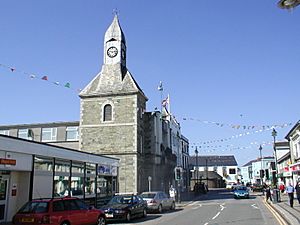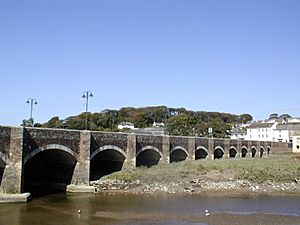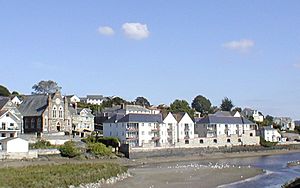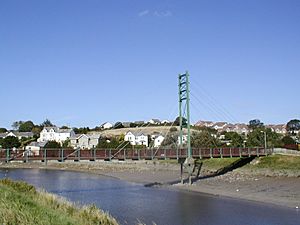Wadebridge facts for kids
Quick facts for kids Wadebridge
|
|
|---|---|
 Looking along The Platt towards Wadebridge Town Hall |
|
| Lua error in Module:Location_map at line 530: Unable to find the specified location map definition: "Module:Location map/data/Cornwall (mainland)" does not exist. | |
| Population | 7,900 (2011) |
| OS grid reference | SW990725 |
| Civil parish |
|
| Unitary authority | |
| Ceremonial county | |
| Region | |
| Country | England |
| Sovereign state | United Kingdom |
| Post town | WADEBRIDGE |
| Postcode district | PL27 |
| Dialling code | 01208 |
| Police | Devon and Cornwall |
| Fire | Cornwall |
| Ambulance | South Western |
| EU Parliament | South West England |
| UK Parliament |
|
Wadebridge (also called Ponswad in Cornish) is a town in north Cornwall, England. It is located on the River Camel, about 5 miles (8 km) upstream from Padstow. In 2011, about 7,900 people lived here.
The town was first known as Wade. It was a tricky place to cross the river until a bridge was built in the 1400s. After the bridge was finished, the town became known as Wadebridge. This bridge was very important during the English Civil War. Oliver Cromwell even visited to take control of it.
Wadebridge had a railway station from 1834 to 1967. Part of the old railway line is now the Camel Trail. This trail is a popular path for walking, cycling, and horse riding. The town used to have a lot of traffic, but a bypass was built in 1991. Now, the main shopping street, Molesworth Street, is a pedestrian area.
The town has a secondary school. Many famous sports stars went to school there. The Royal Cornwall Show is a big farming event held nearby every June. The Cornwall Folk Festival also takes place around August Bank Holiday.
Contents
History of Wadebridge
Early Days of Wade
The town started because there was a place to cross the River Camel. The river's name "Camel" probably means "crooked one." Before the bridge, people had to wade across the river at low tide. There were small chapels on each side of the river. People would pray for a safe journey before crossing and give thanks afterwards.
In 1312, King Edward II allowed Wade to have a market and two yearly fairs. Wade was part of the St Breock parish. The river separated it from the nearby Egloshayle parish.
Building the Bridge
Later, a ferry helped people cross the river. But many people and animals still had trouble crossing the River Camel. So, Reverend Thomas Lovibond decided to build a bridge. It was finished in 1468. After that, Wade became known as Wadebridge.
People used to say the bridge was built on wool sacks. This is why it was sometimes called the "Bridge on Wool." However, we now know it was built directly on the strong rock underneath. The bridge was very important during the English Civil War. In 1646, Oliver Cromwell came with his soldiers to take control of it.
The bridge has been made wider several times. It was widened in 1853, 1952, and again in 1963.
The Railway Story
The Bodmin and Wadebridge Railway was built to carry sand from the Camel Estuary. This sand was used as fertiliser on farms. It cost £35,000 to build. The railway opened on September 30, 1834. It was one of the first railways in Britain to carry passengers. The first train was pulled by a locomotive called Camel.
The last passenger train left Wadebridge railway station in 1967. Today, the old railway path is the Camel Trail. A heritage railway, the Bodmin and Wenford Railway, now runs on part of the route.
Busy Quays and Trade
Wadebridge was the highest point on the River Camel where ships could travel. This made it an important trading place before the railway was built. Ships brought goods from Bristol and coal from South Wales. Timber also came from the Baltic. Stone from inland areas was sent to other parts of England.
The first locomotives for the railway were brought in through the quay. They were made by Neath Abbey Ironworks. The railway was designed to connect well with river traffic. It helped move sand from the river to local farms.
By the 1950s, the river became very silty. This made it hard for large ships to reach Wadebridge. The ketch Agnes was probably the last ship to bring cargo to Wadebridge in 1955.
Eddystone Lighthouse Connection
In 1877, a new Eddystone Lighthouse was needed. Granite stone from De Lank quarry was brought to Wadebridge. Stonemasons carefully shaped each piece of stone. They made sure each piece fit perfectly with the ones next to it and above and below it. As each layer was ready, it was sent by sea to the Eddystone rocks. The lighthouse was finished in 1882. The road where the masons worked is now called Eddystone Road.
Wadebridge in Wartime
During World War I, Wadebridge welcomed refugees from the Netherlands and Belgium. A building in Park Street was turned into a chapel for them.
In World War II, three bombs were dropped on a hill above Fernleigh Road. Luckily, no one was hurt, and there was only minor damage.
Geography of Wadebridge
Wadebridge is located on the River Camel. The town centre is on the west side of the river.
In 1965, there was a big flood in Wadebridge. Heavy rain caused the river to rise. The Swan Hotel on The Platt was flooded with about one and a half feet of water.
Getting Around Wadebridge
For many years, Wadebridge had a lot of traffic because the A39 road went right through it. But in 1991, a bypass was built around Wadebridge and Egloshayle. This helped the towns become much nicer. The main shopping street in Wadebridge, Molesworth Street, is now a pedestrian area. This means people can shop without worrying about cars.
Local buses are run by Go Cornwall Bus and Kernow. You can take buses to places like Boscastle, Bude, Launceston, Padstow, and Truro.
Wadebridge no longer has its own national railway station. It closed in 1967. The closest train station is now Bodmin Parkway. From there, you can catch trains to Plymouth, Cardiff, London Paddington, and Penzance.
Culture and Community
The Molesworth Arms is one of the oldest inns in Wadebridge. It has been known by different names over the years, like The Fox and The King's Arms. It got its current name in 1817.
Every year, the MayPlay festival kicks off the events in Wadebridge. It's a weekend of free activities for children.
The Royal Cornwall Agricultural Show is a huge farming show. It takes place over three days in early June. The showground is about 1.5 miles (2.4 km) west of Wadebridge. This show started in 1793 and moved to its current location in 1960. The showground is also used for many other events, like Scout Jamborees.
The Big Lunch is a free street party held in Molesworth Street. Around 500 to 750 people gather to share food, chat, and enjoy music. This idea came from the Eden Project.
In June, the Wadebridge Lions organize a Beer Festival. It features beers from all over Cornwall and lots of live music.
July brings the Rock Oyster Festival to fields near the town. You can enjoy oysters, local bands, and music from further away.
The Wadebridge Carnival is held every August. It features a Carnival Queen and a parade. There is also the Eglos Craft Fayre at Egloshayle Church.
The Cornwall Folk Festival is one of the UK's oldest folk festivals. It runs for five days around the August Bank Holiday. It focuses on folk, bluegrass, and acoustic music. Famous musicians from around the world and local Cornish bands perform here.
The Camel River Festival is held around August or September, depending on the tides. The main event is a series of raft races on the river. There's also food, drinks, stalls, and more live music.
In October, the Bikelights procession takes place. Youngsters decorate their bicycles with lights, and they parade through the town centre.
In November, the Prime Stock Show and the Garden Produce Association and Chrysanthemum Show are held.
A footbridge called the Challenge Bridge connects the Egloshayle playing fields to the Jubilee fields. This bridge was built in 1991 for a TV show called "Challenge Anneka." Locals sometimes call it Anneka's Bridge.
The local newspaper is a special edition of the weekly Cornish Guardian.
Wadebridge is twinned with Langueux in Brittany, France.
In 2013, Wadebridge was chosen as one of Britain's top eco-towns. It is home to the Wadebridge Renewable Energy Network. This group aims to make Wadebridge the first town in the UK powered entirely by solar and renewable energy.
The Wadebridge and District Museum opened in 2007. It moved to its current location on Chapel Lane in 2013.
Education and Health
Wadebridge has two primary schools: Wadebridge Primary Academy and St. Breock Primary School. Both are highly rated. There is also a secondary school, Wadebridge School.
The town has two health centres: the Wadebridge and Camel Estuary Practice and the Bridge Medical Centre. Doctors have been working together in Wadebridge since the early 1900s.
In 1901, the population of Wadebridge was 3,470. By 2001, it had grown to 6,222.
Sports in Wadebridge
Cornish Wrestling
Wadebridge has been a centre for Cornish wrestling for many years. Tournaments have been held at places like Bodieve Park and the Cricket Ground. Wadebridge hosted the Interceltic games in 1965, 1967, 2006, 2008, and 2010.
Team Sports
Wadebridge is home to several sports clubs. These include Wadebridge Town Football Club, who play at Bodieve Park. The Wadebridge Camels rugby team plays at the Molesworth Field in Egloshayle. Wadebridge Cricket Club has played at Egloshayle Park since the 1950s. The town also has a leisure centre with many sports activities, including Cornish wrestling.
Water Sports and Golf
The Camel estuary is a great place for water sports. You can enjoy sailing, water skiing, windsurfing, surfing, and kite surfing. There are also golf courses nearby, such as Trevose and Saint Enodoc.
Famous People from Wadebridge
Many interesting people have connections to Wadebridge.
- Sir Goldsworthy Gurney, a scientist and surgeon, lived in Wadebridge from 1814 to 1820. He invented the Bude-Light. A street in town is named Goldsworthy Way after him.
- Francis Hurdon (1834–1914), an important person in Canadian politics, went to school in Wadebridge.
- Michael White, a journalist for The Guardian, was born here in 1945.
- Andrew Ridgeley, from the pop group Wham!, and Keren Woodward, from Bananarama, lived near the town.
- Olly Barkley, an England rugby union player, grew up in Wadebridge.
- Michaela Breeze, a Commonwealth weightlifting champion, also grew up here.
- Annabel Vernon, a 2007 World Rowing Champion, was educated at Wadebridge School.
See also
 In Spanish: Wadebridge para niños
In Spanish: Wadebridge para niños




